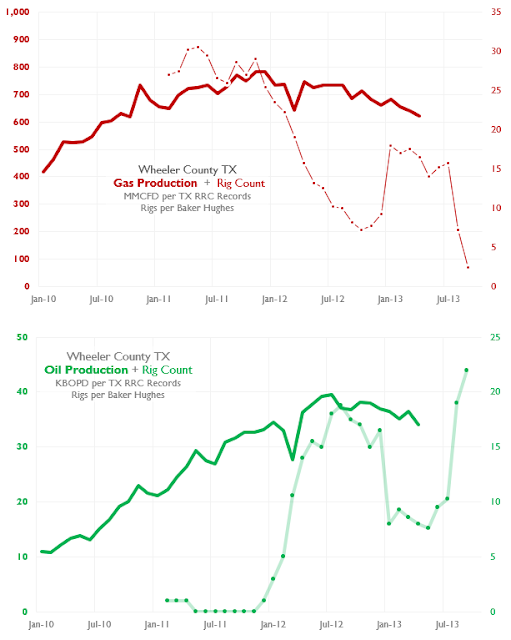- Classification of the rig, like the drilling permit itself, is at the driller's discretion in many cases. And drillers are motivated to find more liquids and less gas, and convince investors that they are doing so.
- Drilling targets contain meaningful amounts of both oil and gas, more so than in the past.
- Production results don't seem to be well correlated to rig counts.
This issue has been widely reported, but not quantified. Here is an example that is more than anecdotal, and it gives some insight into what is really going on.
I looked for an example that had these characteristics:
- Both oil and gas targets
- Both oil and gas rig counts
- Good data
- A basin where gas and oil were found together in the zones being targeted.
I picked the epicenter of the Granite Wash, Wheeler County Texas. Here are the basics. (Oil includes condensate.)
Some initial observations:
- Rig counts are very current (through Sep 13), but production goes only through April. Some production is reported through June, but it is likely not a complete account, so there is the lag is reporting, plus the obvious lag between drilling and production.
- Drill times are averaging around 25-30 days overall in the Granite Wash.
- Oil rig counts were zero or thereabouts for nearly all of 2011, yet oil production steadily grew from about 21 KBOPD to 34.
- In January 2013, an abrupt reclassification of 8-10 rigs took place, from gas to oil.
From a BTU standpoint, Wheeler still produces about 3x as much gas as oil, but gas has been in apparent decline since Jan '12, and oil is trailing off but less so. There may be gas takeaway constraints in this area, but that would not explain a decline in gas production, unless dry gas was in decline and wet gas production was increasing.
Chesapeake produces almost half the oil in the county, so their own rig classification and production history will explain this in further detail.

